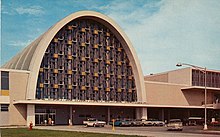Moise H. Goldstein Sr.
Moise H. Goldstein Sr. | |
|---|---|
| Born | September 17, 1882 |
| Died | December 28, 1972 (aged 90) |
| Occupation | Architect |
| Parent(s) | Father: Julius Goldstein Mother: Julie Schwartz Goldstein |
Moise Herbert Goldstein Sr. (September 17, 1882 − December 28, 1972) was an architect in Louisiana during the first half of the 20th century whose work includes hotels, a 23-story bank building, government buildings, airport terminal, the main library building, and a synagogue. In 1936, he was elected to Fellowship status in the American Institute of Architects and was elevated to Member Emeritus in 1961.[2] Goldstein was a founding member of the Louisiana Architect's Association and was an active participant in establishing the School of Architecture at Tulane University.[2]
Biography
[edit]Education
[edit]After attending public schools in New Orleans, Goldstein obtained a Bachelor of Engineering degree from Tulane University in 1902.[2] By 1905, he had earned an MS degree from Massachusetts Institute of Technology. In 1906, Goldstein attended the American Academy in Rome, devoting a year of study in France, Italy, and Turkey.
Career
[edit]
After returning to New Orleans, Goldstein joined the architectural firm of Diboll, Owen, and Goldstein, but in 1914, he established his own company.[3] It was during this time that he designed the Pine Hills Hotel in Bay St. Louis, Mississippi, as well as, the American Bank building and Temple Sinai in New Orleans.[3] In the 1930s, Goldstein designed the original buildings for Dillard University, and served as campus architect from 1934 through 1961.[2][4]
From 1929 to 1946, Goldstein served on the Audubon Park Commission and was active in construction projects at Audubon Zoo.[2] During the Great Depression, Goldstein drafted designs and prepared blueprints for new construction at the zoo, to take advantage of WPA labor and New Deal funding.[5]

In 1947, two architects joined Goldstein as partners, and the new architectural firm became Goldstein, Parham, and Labouisse. Through the 1950s, the firm's designs included an elementary school, a state office building, the main branch of the New Orleans Public Library, a court building, and the Moisant Airport terminal, which became Louis Armstrong International Airport.[3]
In 1962, Goldstein ended his partnership with Parham, and Labouisse, and entered into practice with his son, forming Moise H. Goldstein; Louis A. Goldstein, architects, but the elder Goldstein retired in 1963.[2]
Death
[edit]Moise Goldstein died December 28, 1972, and was interred at Metairie Cemetery, New Orleans, Louisiana.
Work
[edit]

- Union Indemnity building at 837 Gravier Street (1924), designed by Goldstein with Favrot and Livaudais, architects. Now Gravier Place Apartments[citation needed]
- Pine Hills Hotel in Bay St. Louis, Mississippi

- National American Bank Building in New Orleans
- Temple Sinai (1928) on St. Charles Avenue in New Orleans
- Original buildings for Dillard University
- Main branch New Orleans Public Library[6]
- Moisant Airport terminal[7]
References
[edit]- ^ The Historic New Orleans Collection, Artist Database—Goldstein, Moise H. Retrieved 2015-05-25.
- ^ a b c d e f Moise Goldstein Office Records, Southeastern Architectural Archive, Special Collections Division, Tulane University Libraries Archived 2015-05-26 at the Wayback Machine Retrieved 2015-05-25.
- ^ a b c Scheuermann Jr, Milton G. 2011. KnowLA Encyclopedia of Louisiana—Moise H. Goldstein. David Johnson (ed). Louisiana Endowment for the Humanities Retrieved 2015-05-25.
- ^ Campus Heritage Network: Dillard University Retrieved 2015-05-25.
- ^ Jesse C. Donahue and Erik K. Trump. 2010. American Zoos during the Depression: A New Deal for Animals. McFarland & Co., Inc. p. 33. Retrieved 2015-05-25.
- ^ Moise H. Goldstein Office Records|SOUTHEASTERN ARCHITECTURAL ARCHIVE COLLECTION 4
- ^ "New Orleans airport's new terminal debuts 60 years after original MSY opened". wwltv.com. November 5, 2019. Retrieved 2022-06-27.
External links
[edit]- "Moise Goldstein". Find a Grave. Retrieved 2015-05-25.
